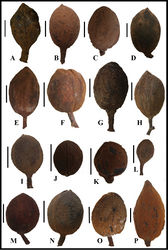Virola megacarpa
| Notice: | This page is derived from the original publication listed below, whose author(s) should always be credited. Further contributors may edit and improve the content of this page and, consequently, need to be credited as well (see page history). Any assessment of factual correctness requires a careful review of the original article as well as of subsequent contributions.
If you are uncertain whether your planned contribution is correct or not, we suggest that you use the associated discussion page instead of editing the page directly. This page should be cited as follows (rationale):
Citation formats to copy and paste
BibTeX: @article{Santamaría-Aguilar2019PhytoKeys134, RIS/ Endnote: TY - JOUR Wikipedia/ Citizendium: <ref name="Santamaría-Aguilar2019PhytoKeys134">{{Citation See also the citation download page at the journal. |
Ordo: Magnoliales
Familia: Myristicaceae
Genus: Virola
Name
Virola megacarpa A. H. Gentry. – Wikispecies link – Pensoft Profile
- Virola megacarpa A. H. Gentry. Ann. Missouri Bot. Gard. 62(2): 474. 1975. Type. Panama. Colón: Santa Rita Ridge, 23 Mar 1972 [fr], [A. H.] Gentry & [J. D.] Dwyer 4804 (holotype: MO!; isotypes: BM!*, MEXU!*, WIS!*).
Distinctive characters
Virola megacarpa can be recognised by its large and oblong leaf blades (20.3–37 × 7–13 cm) with numerous [(32–) 40–50 per side], dense lateral veins and a densely pubescent abaxial surface with dark brown to ferruginous dendritic trichomes (Fig. 3I). It is also the species with the largest fruits (4–5.7 × 2–2.9 cm) in the region and likely the genus; these are also densely pubescent with an acuminate to rostrate apex (Fig. 4P) and thick pericarp (3–6 mm).
Distribution
Virola megacarpa is only known from Panama (Colón, Panamá, San Blas and Veraguas) (Fig. 18C) from 50–550 m elevation.
This species is attributed to Colombia in Cogollo (2011)[1], based on the specimen J. Brand 1252 (JAUM!*; fr). It is also mentioned as occurring in Colombia in Gradstein (2016)[2] and Ulloa Ulloa et al. (2017)[3], though these references do not mention a voucher specimen (likely they refer back to the same specimen cited by Cogollo [2011][1]). The first author has seen a digital image of this specimen (J. Brand 1252, JAUM) and it appears that the leaf undersurface and fruits are scarcely pubescent, as well as smaller. This specimen clearly corresponds to a species of the group Surinamenses sensu Smith and Wodehouse (1938)[4] and not V. megacarpa. For that reason, V. megacarpa is considered restricted to Mesoamerica.
Common names
None recorded.
Phenology
The only observed herbarium specimen with flowers (these staminate) was collected in August. Fruits were collected in February and March and August to November.
Field characters
Plants are trees 12–30 m tall and 21.5–53 cm DBH. Damaged bark releases exudate that is red or that oxidises reddish-brown. Flowers have pale yellow perianth. Fruits are densely pubescent with brown trichomes and a red aril.
Discussion
Vegetatively, Virola megacarpa can be confused with V. koschnyi and some specimens have been identified as the latter (e.g. G. de Nevers & H. Herrera 7917, MO). Both species share leaf blades with numerous and conspicuous lateral veins and pediculate trichomes on the abaxial surface. However, V. megacarpa has more lateral veins per side [(32–) 40–50 vs. (16–) 20–35] and these are more closely spaced (Figs 8G and I) and fruits are larger (4–5.7 × 2–2.9 cm vs. 1.9–3.1 × 1.5–1.9 cm) (Fig. 4F, P).
Specimens examined
Panama. Colón: East of Portobelo, 50–100 m elev., 12 Oct 1992 (fr), G. McPherson & M. Richardson 15873 (MO!); Teck Cominco Petaquilla mining concession, 220 m elev., 20 Feb 2008 (fr), G. McPherson & M. Merello 20081 (MO!); East ridge, no elev., 23 Feb 1968 (fr), J. A. Duke 15261 (MEXU!*, MO!). Panamá: [Chepo] El Llano-Cartí road, 5 km N of Pan-American Highway at El Llano, 300 m elev., 10–11 Nov 1973 (imm fr), M. Nee 7920 (MEXU!*, MO!); El Llano-Cartí road, 16–18.5 km by road N of PanAmerican Hwy, at El Llano, 400–450 m elev., 28 Mar 1974 (fr), M. Nee & E. Tyson 10983 (CR!, F!*, INPA!*, MO-2 sheets!). San Blas: El Llano-Cartí Road, Km 19.1, 350 m elev., 19 Mar 1985 (fr), G. de Nevers 5184 (INPA!*, MEXU!*, MO!). Veraguas: Santa Fe, Valley of Río Dos Bocas along road between Escuela Agricola Alto Piedra and Calovebora, 450–550 m elev., 31 Aug 1974 (♂ fl), T. B. Croat 27785 (INPA!*, MO!).
Taxon Treatment
- Santamaría-Aguilar, D; Aguilar, R; Lagomarsino, L; 2019: A taxonomic synopsis of Virola (Myristicaceae) in Mesoamerica, including six new species PhytoKeys, 134: 1-82. doi
Images
|
Other References
- ↑ 1.0 1.1 Cogollo Á (2011) Myristicaceae. In: Idárraga-Piedrahita A Ortiz R Callejas Posada R Merello M (Eds) Flora de Antioquia: Catálogo de las Plantas Vasculares, Listado de las plantas vasculares del departamento de Antioquia.Universidad de Antioquia, Medellín2: 641–644.
- ↑ Gradstein S (2016) Virola. In: Bernal R, Gradstein SR, Celis M (Eds) Catálogo de plantas y líquenes de Colombia. Instituto de Ciencias Naturales, Universidad Nacional de Colombia, Bogotá. http://catalogoplantasdecolombia.unal.edu.co
- ↑ Ulloa Ulloa C, Acevedo-Rodríguez P, Beck S, Belgrano M, Bernal R, Berry P, Brako L, Celis M, Davidse G, Forzza R, Gradstein S, Hokche O, León B, León-Yánez S, Magill R, Neill D, Nee M, Raven P, Stimmel H, Strong M, Villaseñor J, Zarucchi J, Zuloaga F, Jørgensen P (2017) An integrated assessment of the vascular plant species of the Americas.Science358(6370): 1614–1617. https://doi.org/10.1126/science.aao0398
- ↑ Smith A, Wodehouse R (1938) The American species of Myristicaceae.Brittonia2(5): 393–510. https://doi.org/10.2307/2804799




